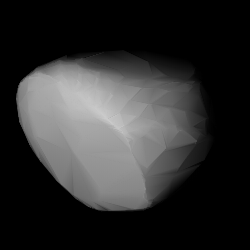Physical characteristics
Owing to its early discovery date, Ganymed has a rich observational history. A 1931 paper published the absolute magnitude, based on observations to date, as 9.24, [16] slightly brighter than the present value of 9.45.
Ganymed is a stony S-type asteroid, in the Tholen, SMASS and in the S3OS2 taxonomy. This means that it is relatively reflective and composed of iron and magnesium silicates. Spectral measurements put Ganymed in the S (VI) spectral subtype, [13] indicating a surface rich in orthopyroxenes, and possibly metals (although if metals are present they are covered and not readily apparent in the spectra). [13]
Diameter and albedo
According to the surveys carried out by the Infrared Astronomical Satellite IRAS, the Japanese Akari satellite and the NEOWISE mission of NASA's Wide-field Infrared Survey Explorer (WISE), Ganymed measures between 31.66 and 37.67 kilometers in diameter and its surface has an albedo between 0.238 and 0.293. [5] [6] [7] [8] [9]
The Collaborative Asteroid Lightcurve Link derives an albedo of 0.2809 and a mean-diameter of 31.57 kilometers based on an absolute magnitude of 9.50. [10] Carry published a diameter 34.28±1.38 kilometers in 2012. [17]
An occultation of a star by Ganymed was observed from California on 22 August 1985. [4] Additional observations in 2011 gave an occultation cross-section with a semi-major and minor axis of 39.3 and 18.9 kilometers, respectively. [4]
Rotation and poles
A large number of rotational lightcurves of Ganymed have been obtained from photometric observations since 1985. [18] [19] [20] [14] [21] [22] [23] [24] [25] Analysis of the best-rated lightcurves obtained by American photometrist Frederick Pilcher at his Organ Mesa Observatory ( G50 ) in New Mexico during 2011 gave a rotation period of 10.297 hours with a consolidated brightness amplitude between 0.28 and 0.31 magnitude ( U=3-/3/3 ). [10] [11]
Three studies using modeled photometric data from the Uppsala Asteroid Photometric Catalogue, WISE thermal infrared data and other sources, gave a concurring period of 10.313, 10.31284, and 10.31304 hours, respectively. Each modeled lightcurve also determined two spin axes of (214.0°, −73.0°), (190.0°, −78.0°), as well as (198.0°, −79.0°) in ecliptic coordinates (λ, β; L1/B1), respectively. [26] [27] [28]
In 1998, radar observations of Ganymed by the Arecibo radio telescope produced images of the asteroid, revealing a roughly spherical object. [29] Polarimetric observations conducted by Japanese astronomers concluded that there was a weak correlation between the object's light- and polarimetry curve as a function of rotation angle. [30] Because polarization is dependent on surface terrain and composition, rather than the observed size of the object like the lightcurve, this suggests that the surface features of the asteroid are roughly uniform over its observed surface. [30]
This page is based on this
Wikipedia article Text is available under the
CC BY-SA 4.0 license; additional terms may apply.
Images, videos and audio are available under their respective licenses.

